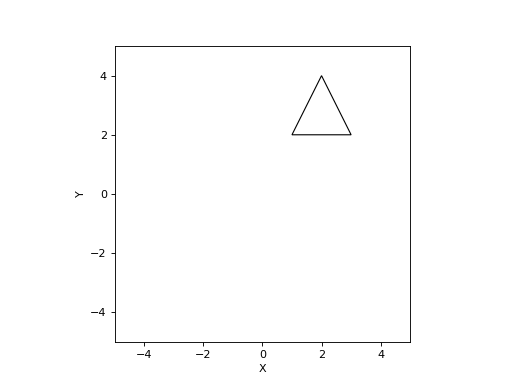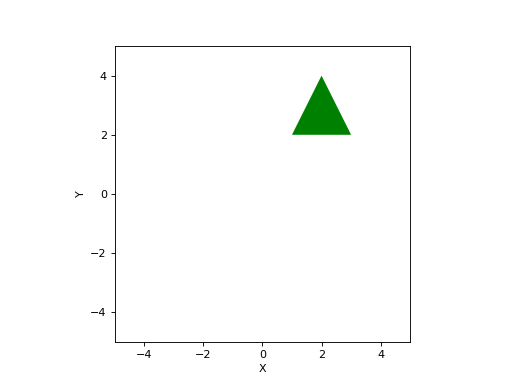2D polgon
- class Polygon2(vertices=None, close=True)[source]
Class to represent 2D (planar) polygons
Note
Uses Matplotlib primitives to perform transformations and intersections.
- __init__(vertices=None, close=True)[source]
Create planar polygon from vertices
- Parameters:
vertices (ndarray(2, N), optional) – vertices of polygon, defaults to None
close (
bool) – closes the polygon, replicates the first vertex, defaults to True
Create a polygon from a set of points provided as columns of the 2D array
vertices. A closed polygon is created so the last vertex should not equal the first.Example:
>>> from spatialmath import Polygon2 >>> p = Polygon2([(1, 2), (3, 2), (2, 4)])
Warning
The points must be sequential around the perimeter and counter clockwise, otherwise moments will be negative.
Note
The polygon is represented by a Matplotlib
Path
- __len__()[source]
Number of vertices in polygon
- Returns:
number of vertices
- Return type:
int
Example:
>>> from spatialmath import Polygon2 >>> p = Polygon2([(1, 2), (3, 2), (2, 4)]) >>> len(p) 3
- __str__()[source]
Polygon to string
- Returns:
brief summary of polygon
- Return type:
str
Example:
>>> from spatialmath import Polygon2 >>> import numpy as np >>> p = Polygon2(np.array([[1, 3, 2], [2, 2, 4]])) >>> print(p) Polygon2 with 4 vertices
- animate(T, **kwargs)[source]
Animate a polygon
- Parameters:
T (SE2) – new pose of Polygon
kwargs – options passed to Matplotlib
Patch
- Return type:
None
The plotted polygon is moved to the pose given by
T. The pose is always with respect to the initial vertices when the polygon was constructed. The vertices of the polygon will be updated to reflect what is plotted.If the polygon has already plotted, it will keep the same graphical attributes. If new attributes are given they will replace those given at construction time.
- Seealso:
- area()[source]
Area of polygon
- Returns:
area
- Return type:
float
Example:
>>> from spatialmath import Polygon2 >>> p = Polygon2([(1, 2), (3, 2), (2, 4)]) >>> p.area() 2.0
- Seealso:
- bbox()[source]
Bounding box of polygon
- Returns:
bounding box as [xmin, xmax, ymin, ymax]
- Return type:
ndarray(4)
Example:
>>> from spatialmath import Polygon2 >>> p = Polygon2([(1, 2), (3, 2), (2, 4)]) >>> p.bbox() array([1., 2., 3., 4.])
- centroid()[source]
Centroid of polygon
- Returns:
centroid
- Return type:
ndarray(2)
Example:
>>> from spatialmath import Polygon2 >>> p = Polygon2([(1, 2), (3, 2), (2, 4)]) >>> p.centroid() array([2. , 2.6667])
- Seealso:
- contains(p, radius=0.0)[source]
Test if point is inside polygon
- Parameters:
p (array_like(2)) – point
radius (float, optional) – Add an additional margin to the polygon boundary, defaults to 0.0
- Returns:
True if point is contained by polygon
- Return type:
bool
radiuscan be used to inflate the polygon, or if negative, to deflated it.Example:
>>> from spatialmath import Polygon2 >>> p = Polygon2([(1, 2), (3, 2), (2, 4)]) >>> p.contains([0, 0]) False >>> p.contains([2, 3]) True
Warning
Returns True if the point is on the edge of the polygon but False if the point is one of the vertices.
Warning
For a polygon with clockwise ordering of vertices the sign of
radiusis flipped.- Seealso:
matplotlib.contains_point()
- edges()[source]
Iterate over polygon edge segments
Creates an iterator that returns pairs of points representing the end points of each segment.
- Return type:
Iterator
- intersects(other)[source]
Test for intersection
- Parameters:
other (Polygon2 or Line2 or list(Polygon2) or list(Line2)) – object to test for intersection
- Returns:
True if the polygon intersects
other- Return type:
bool
- Raises:
ValueError –
Returns true if the polygon intersects the the given polygon or 2D line. If
otheris a list, test against all in the list and return on the first intersection.
- moment(p, q)[source]
Moments of polygon
- Parameters:
p (int) – moment order x
q (int) – moment order y
- Return type:
float
Returns the pq’th moment of the polygon
\[M(p, q) = \sum_{i=0}^{n-1} x_i^p y_i^q\]Example:
>>> from spatialmath import Polygon2 >>> p = Polygon2([(1, 2), (3, 2), (2, 4)]) >>> p.moment(0, 0) # area 2.0 >>> p.moment(3, 0) 18.0
Note is negative for clockwise perimeter.
- plot(ax=None, **kwargs)[source]
Plot polygon
- Parameters:
ax (Axes, optional) – axes in which to draw the polygon, defaults to None
kwargs – options passed to Matplotlib
Patch
- Return type:
None
A Matplotlib Patch is created with the passed options
**kwargsand added to the axes.Examples:
>>> from spatialmath.base import plotvol2, plot_polygon >>> plotvol2(5) >>> p = Polygon2([(1, 2), (3, 2), (2, 4)]) >>> p.plot(fill=False) >>> p.plot(facecolor="g", edgecolor="none") # green filled triangle
(
Source code,png,hires.png,pdf)
(
Source code,png,hires.png,pdf)
- Seealso:
animate()matplotlib.PathPatch()
- radius()[source]
Radius of smallest enclosing circle
- Returns:
radius
- Return type:
float
This is the radius of the smalleset circle, centred at the centroid, that encloses all vertices.
Example:
>>> from spatialmath import Polygon2 >>> p = Polygon2([(1, 2), (3, 2), (2, 4)]) >>> p.radius() 1.3333333333333335
- transformed(T)[source]
A transformed copy of polygon
Returns a new polgyon whose vertices have been transformed by
T.Example:
>>> from spatialmath import Polygon2, SE2 >>> p = Polygon2([(1, 2), (3, 2), (2, 4)]) >>> p.vertices() array([[1., 3., 2.], [2., 2., 4.]]) >>> p.transformed(SE2(10, 0, 0)).vertices() # shift by x+10 array([[11., 13., 12.], [ 2., 2., 4.]])
- vertices(unique=True)[source]
Vertices of polygon
- Parameters:
unique (bool, optional) – return only the unique vertices , defaults to True
- Returns:
vertices
- Return type:
ndarray(2,n)
Returns the set of vertices. The polygon is always closed, that is, the first and last vertices are the same. The
uniqueoption does not include the last vertex.Example: